How Do I Continue My Program After Systemin
Start, Stop, Continue is a simple feedback tool that can help you continually improve over time that works at both an individual and team level.
Many people struggle to both give and receive constructive feedback. Why? Because feedback can be uncomfortable. It can be uncomfortable to challenge your team's performance, and it can be equally as uncomfortable to receive challenging feedback on your performance.
Because feedback can be uncomfortable, many managers put off giving frank feedback. They know that feedback can improve their team's performance, but fear that if taken the wrong way, triggering a fight or flight response, it will have the opposite effect and reduce performance.
Wouldn't it be great if there was a simple tool you could use to overcome these challenges and, as a result, make your team more productive and increase collaboration? Well, Start, Stop, Continue might be just the tool for you.
What is Start, Stop, Continue?
Start, Stop, Continue is a simple exercise, taking less than twenty minutes, that generates three lists.
- Start List: Ideas that you don't currently do but that would be good to start doing.
- Stop List: Things you're currently doing but should stop doing because they're not adding any value.
- Continue List: Things that have been working well and should be adopted as part of your team's core activities.
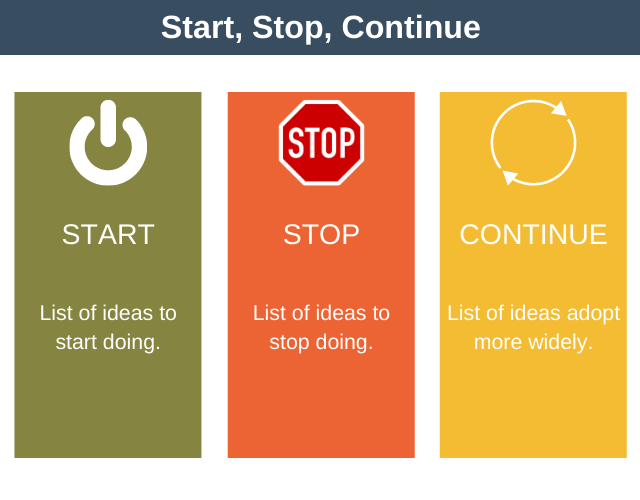
Let's jump in and look at each category in a little more detail.
1. Start
Your start list contains fresh ideas that you'd like to start doing. These actions should focus on:
- Improving existing processes.
- Creating a new process.
- Reducing waste.
- Improving the quality of what you produce.
- Positively impacting how your team feels.
- Improving how your team collaborates.
Remember to include not just technical actions but also behavioral actions.
Questions you can think about to trigger ideas include:
- "If you had a new person join the team, what would you have them work on?"
- "If money was no object, where would invest?"
Ultimately, you want your start list to be a set of fresh ideas to consider trying.
2. Stop
Your stop list contains actions you're currently doing that need to stop. Stopping these activities will free your team up to do more constructive activities. Actions that need to stop are those that:
- Consume time with little reward.
- Distract you from your core purpose.
- Are inefficient.
- Negatively impact how your team feels.
- Are outside of your core competencies.
Remember to include not just technical actions but also behavioral actions.
Questions to think about to trigger ideas include:
- "What activities do you constantly put off? Why do you never get to these activities?"
- "What activities do you think could be eliminated from your working day?"
- "Is there some activity you do that you think is a waste of time?"
Clearing out the deadwood activities can be like a breath of fresh air for your team. Your team will feel more productive and feel like there is more purpose to their work.
3. Continue
Activities to continue are those that are working well but not yet part of your standard practice.
Commonly, these activities will have been introduced in the previous iteration of the Start, Stop, Continue loop and are working well, but you have not yet embedded them into standard practice.
Questions that can help trigger ideas include:
- "Where are we adding the most value?"
- "Are there activities or behaviors that promote our values or culture?"
- "What activities do you find most fulfilling?"
How to Perform a Start, Stop, Continue Session
To perform a Start, Stop, Continue workshop with your team, simply follow the steps below, acting as the meeting facilitator.
- On a wall or large whiteboard, create three columns and label them 'Start,' 'Stop, and 'Continue.'
- Ask each person to spend a minute writing their answers on sticky notes in an actionable way to: "what should we start doing?".
- Do this again for the 'Stop' and 'Continue' columns.
- Ask each team member in turn, to post their sticky notes on to the three columns, explaining each one as they do so. Group related stickies into themes as you go. Discard any that aren't in scope. It can be helpful if you, as the facilitator, go first to model how this should be done to your team.
- Allocate each team member three votes to distribute to the actions they'd like to see implemented. They are free to spend their votes as they choose; they could spend all three votes on one sticky or distribute them across three stickies. Note that you don't have to have three votes. You can have as many as you like; just make sure that each team member has the same number of votes.
- The output from the previous step will be a prioritized list of what your team should start, stop, and continue doing.
- Before wrapping up the session, ensure that each action has an owner and a deadline so they get done in a timely fashion. Finally, email the agreed actions to all your team members.
The model works best when you repeat it at regular intervals, for example, every week or month. That way, you continuously improve over time.
When you hold these meetings regularly, they should take less than 20 minutes to complete.
Start, Stop, Continue Examples
There are many ways you can use Start, Stop, Continue. We'll look at three:
- An agile retrospective.
- Achieving a personal goal.
- Creating a great working environment.
1. An Agile Retrospective
Start, Stop, Continue is often used in agile retrospectives, which are regular postmortems held by agile teams to reflect on what worked, what didn't, and why. They are usually held at the end of each agile sprint or cycle.
The output from an agile retrospective for a single sprint might look like this.
Start:
- Using XYZ software to test all code.
- Ensure all code is checked in at the end of the day.
Stop:
- Starting the daily standup meetings late.
Continue:
- Pair programming.
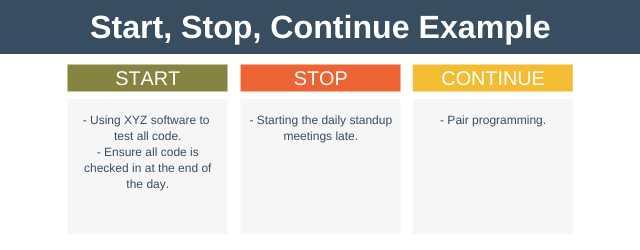
2. Achieving a Personal Goal
Imagine that you want to lose weight gradually over time in a healthy way. Rather than go on a crash diet, you decide to use the Start, Stop, Continue model each week to help you make regular improvements to your food and exercise choices over time.
The output from a single week's Start, Stop, Continue session might look like this.
Start:
- Exercising before work.
- Having healthy breakfasts on weekends.
Stop:
- Throwing your diet out the window when the weekend arrives.
Continue:
- Bringing a homemade lunch to the office.
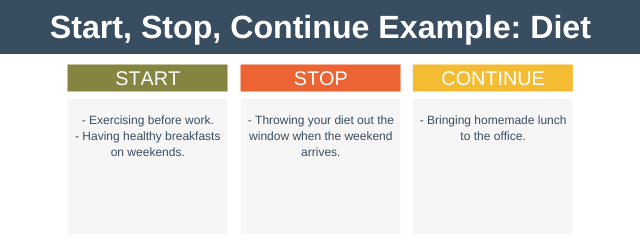
3. Creating a Great Working Environment
Imagine you are managing a team and you want to create the best office working experience for your team in the city. You use Start, Stop, Continue with your team monthly to improve their office experience.
The output from a single months' Start, Stop, Continue session might look like this.
Start:
- Get showers installed for employees to use.
Stop:
- Supplying the free but unhealthy food that appears in the office every Friday.
- Allowing the coffee machine to run out of coffee.
Continue:
- Daily fruit deliveries.
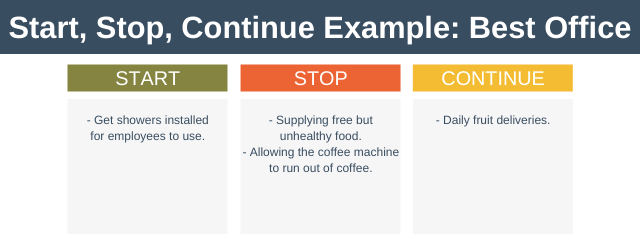
Start, Stop, Continue Template
If you'd like to perform your own Start, Stop, Continue exercise, you can download our Start, Stop, Continue Template here.
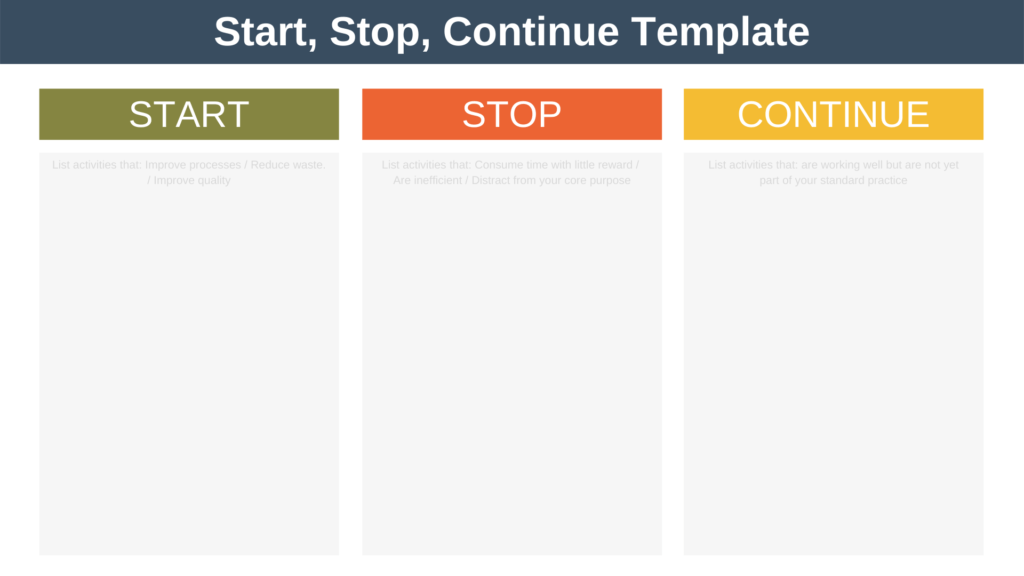
Advantages and Disadvantages
There are several advantages and disadvantages associated with Start, Stop, Continue.
Advantages
- It gives everyone in the team the same opportunity to provide feedback.
- The feedback is action-oriented, allowing you to use it to improve immediately.
- Over time the model can improve quality, reduce waste, and increase employee retention.
Disadvantages
- The model is inward-looking and doesn't prompt you to consider wider issues, such as what industry trends are emerging or what other teams outside your organization are doing.
- The model doesn't provide techniques to generate new ideas to add to each column.
Summary
Start, Stop, Continue is a simple feedback tool that can help you continually improve over time that works at both an individual and team level.
Although the tool is straightforward, it can lead to meaningful improvement over the long term.
Source: https://expertprogrammanagement.com/2022/02/start-stop-continue/
Belum ada Komentar untuk "How Do I Continue My Program After Systemin"
Posting Komentar